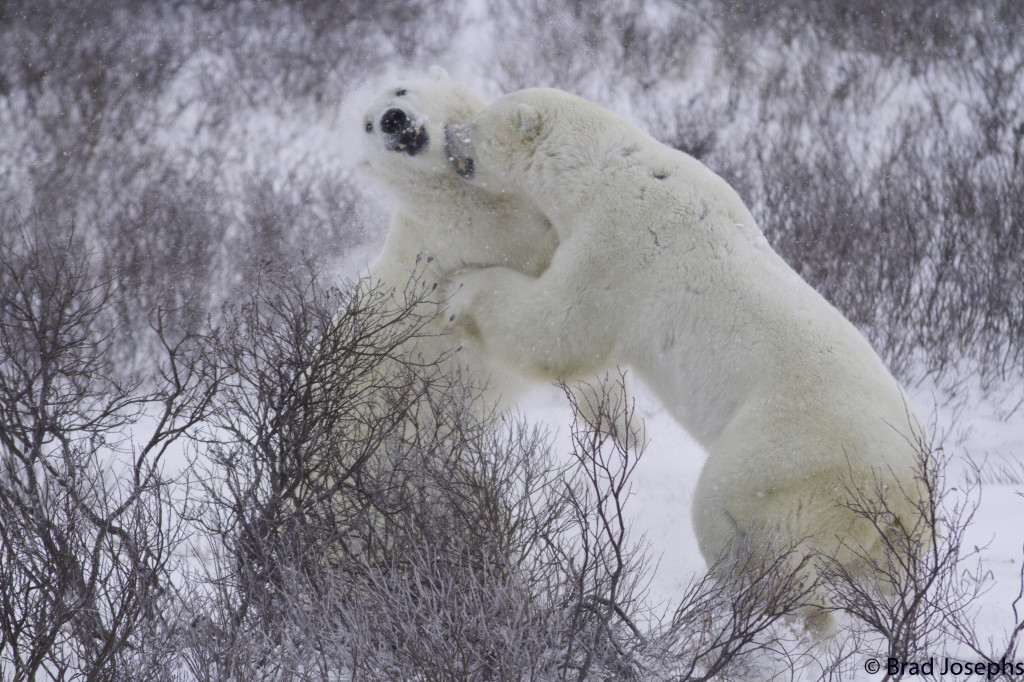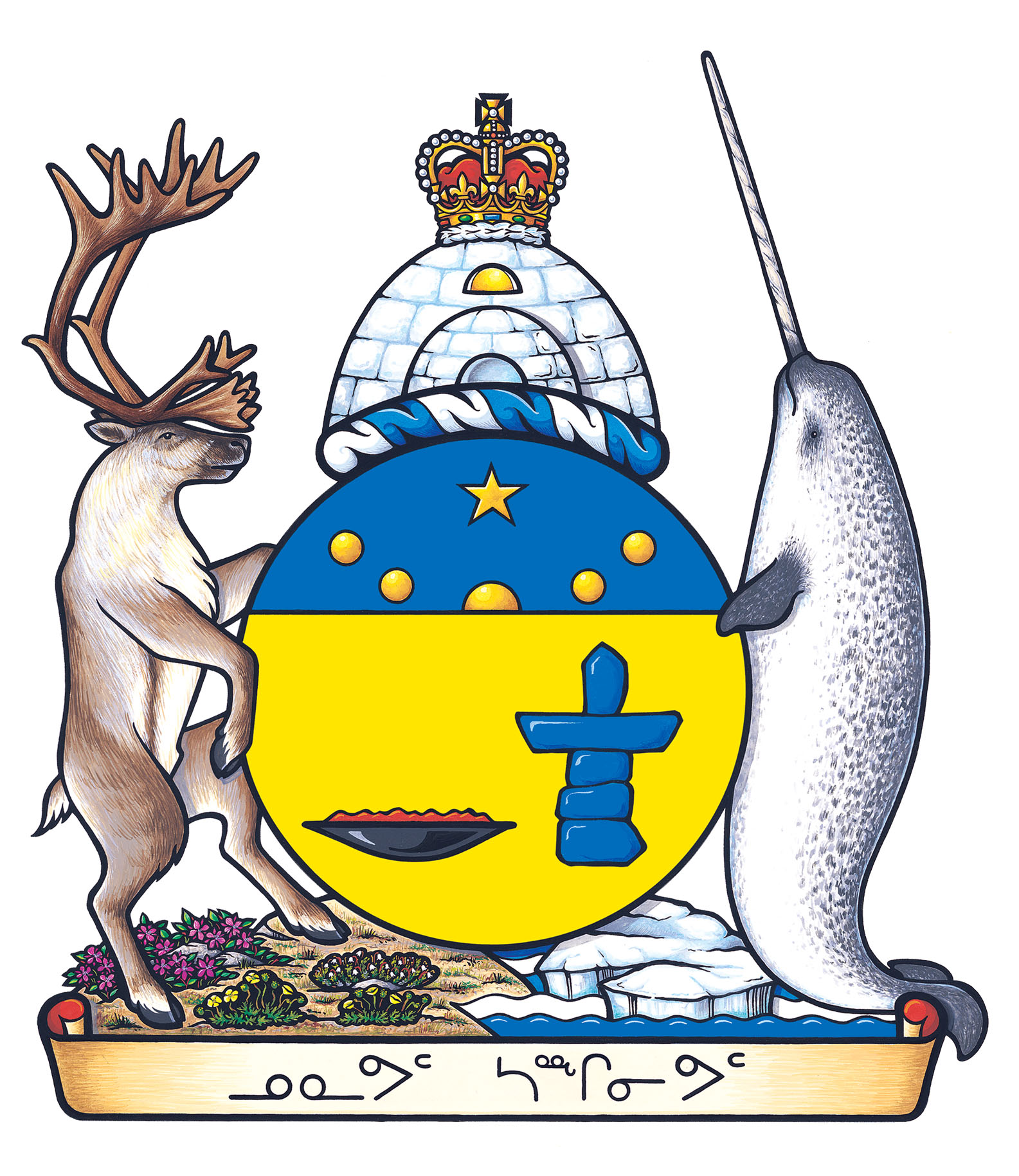by Steve Selden | Jan 24, 2015 | Churchill Photography
Check out these classic shots from Churchill, Manitoba. Polar bear action is quiet around the Churchill Wildlife Management Area these days but will return next October and November. In the meantime take a look at these spectacular polar bear shots!

Polar bears sparring after a snowstorm in Churchill. Brad Josephs photo.

Polar bear testing the ice in Churchill. Natural Habitat Adventures photo.

Sparring polar bears in Churchill, Manitoba. Colby Brokvist photo.

A lone polar bear skirts a pond in Churchill. Eric Rock photo.

Two polar bears sparring near the tundra Lodge. Eric Rock photo.
Want to see polar bears in action in Churchill? Come see the kings of the Arctic this fall!
by Steve Selden | Jan 23, 2015 | Churchill News
It’s hard to believe that Canada’s newest territory is almost 16 years old. April 1, 1999 was the official date Nunavut separated from the Northwest Territories. Comprising a major portion of Northern Canada as well as most of the islands in the Arctic region, Nunavut is the fifth – largest country sub division in the world. Nunavut borders with Manitoba and the waters of the Hudson Bay are included in its borders.

The capital is Iqaluit, formerly Frobisher Bay on Baffin Island. Other major communities include the regional centers of Rankin Inlet and Cambridge Bay. In the far north, Nunavut also includes Ellesmere Island as well as the eastern and southern portions of Victoria Island in the west as well as Akimiski Island in James Bay in the far south. It is the only region of Canada that is not connected to the rest of North America by highway.
The youngest territory is the least populous though largest in overall area of all the provinces and territories of Canada. With a mostly Inuit population of nearly 32,000, Nunavut is a sparsely settled region about the size of Western Europe. Alert, the northernmost inhabited place in the world, is also a part of Nunavut.

The territory of Nunavut. Vabmanagement.com. image.
The territory includes all of the islands in Hudson Bay, James Bay and Ungava Bay. If Nunavut were a country, it would rank 15th in area. The population density is 0.015 persons per square kilometer, one of the lowest in the world. Greenland has approximately the same area and nearly twice the population. Nunavut’s highest point is Barbeau Peak (2,616 m (8,583 ft)) on Ellesmere Island.

Nunavut’s coat of arms. Image courtesy of assembly.nu.ca
Since the 1976 initial proposal by the 82 % Inuit population of Nunavut, the long journey to the current territorial status was delayed by disputes over land claims. So, after 23 years, the territory was born. It seems slightly odd that a native territory took that long to emerge as such. The name “Nunavut” is derived from the Inuit word for “our land”.
by Steve Selden | Jan 22, 2015 | Videos
With the northern lights season drawing near, these two videos of aurora borealis offer a glimpse into the mystical lights that often appear in the heart of winter in Churchill. The second of the two videos is from Churchill and has some unique views capturing the feel of the landscape. Both videos highlight the affect of landscape merged into the footage. The difference between a video of the northern lights in the sky an one with interesting scenery incorporated into the foreground is profound. Whether trees, rocky ledges, houses or igloos, the video’s scenes are transformed when the scenes have more depth. Enjoy these two inspiring videos!
by Steve Selden | Jan 21, 2015 | Churchill News

Port of Churchill in the siege of winter. Steve Selden photo.
With the Port of Churchill processing over 600,000 tonnes of grain last year, the stability of the industry in Churchill has stabilized.
This has alleviated the need to a degree for Omnitrax Canada, owner of the port and Hudson Bay rail line, to continue to press for crude oil shipment by rail to Churchill and subsequent shipping through the port and Hudson Bay.
Environmental activists and farmers have praised Omnitrax for the decision to shelve shipping the oil at this time.
Eric Reder, The Wilderness Committee’s Manitoba campaign director, organized a year-long campaign including town hall meetings in Winnipeg, Thompson and Churchill and solicited over 4,000 protest letters mailed to the provincial and federal governments. The campaign was aimed at raising awareness thus facilitating pressure for the authorities to intervene and prevent Omnitrax from continuing the venture into transporting and shipping oil.
From the start, anyone familiar with the rail-line north from The Pas, knows of the calamity of grain – car derailments over the past decade. It seems irresponsible for any company failing to address those issues first then research and evaluate an emergency recovery plan for derailment of oil cars as well as shipping such a commodity on the pristine Hudson Bay.

“What we were asking of Omnitrax was to find any other product to ship other than crude oil, because every other product than this specific one is easier to clean up,” Reder said. “People from around the world voiced their objection… we are all relieved.”
Churchill
Democratic Member of Parliment (MP) Niki Ashton had a fervent opinion on the issue. “Omnitrax has a lead role to play and I hope they continue to do that and support and respect the livelihoods of northerners”, stated Ashton.
“People didn’t feel safe, not only for the environmental conditions but because the emergency measures aren’t in place at all. Northerners and First Nations leaders spoke out loud and clear… although Omnitrax may not acknowledge that overtly.”
The Wilderness Committee also presented strong anti-shipping points to engaged people and the government. For some of the remote communities along the rail line, this single railway is their only access to the outside world – and to each other. How can oil spill response equipment be transported into these communities, when the only rail line has an accident on it? How do you evacuate people when there is no road into these communities? How do we safeguard the population, the wildlife, and the lands and waters that provide for them, when the only access – the rail line – is blocked by a train derailment?

Port of Churchill with grain ships dockside. Port of Churchill photo.
Suspending crude-oil shipments to Churchill indefinitely was a logical business decision considering the record-breaking success of grain shipments in recent years.
“Having reviewed all of our opportunities and the things we’d like to do, we decided it wasn’t necessary or in our best interests to pursue shipping oil any further,” Stated Omnitrax Canada President Merv Tweed. “I’m convinced that within the next couple of years we’ll hit the million-tonne mark.

Grain vessel awaits docking at the Port of Churchill. Steve Selden photo.
However, the grain market has fluctuated this last decade leading to the break-up of the Canadian Wheat Board’s monopoly with the Port of Churchill. With this history there’s no telling whether soaring grain shipment tonnage will permanently quell Omnitrax’s long term aspirations to ship crude oil through the Port of Churchill. News releases from the company have framed the current status as “suspended”.
by Steve Selden | Jan 20, 2015 | Churchill News
Below freezing temperatures have blown in from the north across the Hudson Bay and settled into the Churchill region lowlands. The snow covered tundra and stunted spruce trees are frosted over and the land has fallen into a deep hibernation for the remainder of winter.
The extended forecast will make most people shiver though in the north they tend to adjust to the cold once it becomes a daily norm. Take a look at the short – term outlook at this Environment Canada website.

Winds and cold temperatures in Churchill. Brad Josephs photo.
With the cold comes general good visibility this time of year. This is the reason, coupled with the higher solar flare activity, that February and March are optimal months for northern lights viewing around the polar regions. In these months the axis of the earth is slightly more aligned with the sun’s axis producing more auroral bands in the region.
The extensive number of clear nights with the occasional winter blizzard make for incredible
northern lights viewing and photography. Extended hours of darkness provide greater opportunities for aurora viewing as well. The snowy landscape enhances the scenes with reflective light. Even half to full moons during these months make for some unique lighting on the landscape and also the chance to get some great photos of the lights and moon together. This is the time to see northern lights in Churchill!

Photography of the northern lights has become a passion in the north. Brad Josephs photo.
Want to see northern lights in Churchill? Check out nathab.com today!
















